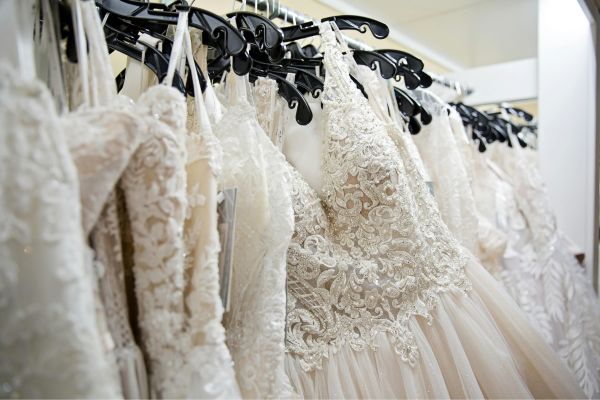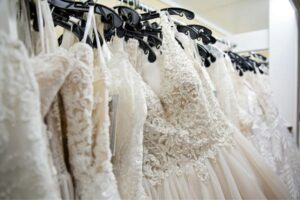Planning your wedding is a whirlwind of emotions—excitement, nerves, joy, maybe even a little panic. And right in the middle of it all? Your wedding dress. The dream gown you’ve imagined since forever. But let’s be real: finding the dress is only half the journey. The other half is making sure it fits you like it was made just for you. That’s where understanding the bridal dress fitting tips and timeline really matters.
So, let’s walk through what you need to know, from the first fitting to the final tweak before the big day. This isn’t some stiff, rule-heavy guide—it’s a friendly roadmap from someone who gets that your time (and sanity) are precious right now.
Why Bridal Dress Fittings Matter More Than You Think
You might fall head-over-heels for your gown the moment you slip it on, but unless you’re incredibly lucky, it won’t fit perfectly right off the rack. Every bride’s body is different—shapes, heights, curves—all beautifully unique. A well-planned fitting schedule ensures that your gown flatters your figure, moves with you, and makes you feel confident from ceremony to dance floor.
The truth is, the perfect fit doesn’t just happen; it’s created through multiple fittings and skilled tailoring. And that takes time.
The Ideal Bridal Dress Fitting Timeline
Here’s where many brides get caught off guard: wedding dress alterations don’t happen overnight. They can take weeks—or even months—depending on how much needs to be adjusted. Knowing the bridal dress fitting tips and timeline in advance helps you stay ahead and avoid last-minute stress.
Start about 8 to 10 months before your wedding.
That’s the sweet spot for ordering your gown, especially if it’s being custom-made. Once it arrives, the fitting phase begins.
Your first fitting should happen around 8 to 10 weeks before the wedding.
This is your initial session to check how the dress fits your body as-is. Your seamstress will pin, tuck, and adjust the gown where needed. Don’t worry if it feels a bit loose or tight—that’s normal. You’re just setting the foundation for a perfect fit.
Your second fitting should be around 4 to 6 weeks before the big day.
By now, the major adjustments are done, and you’re refining details—maybe adjusting the hemline, tightening the waist, or ensuring the neckline sits just right. It’s also a great time to practice walking and sitting in your dress.
Your final fitting happens 1 to 2 weeks before the wedding.
This is where everything comes together. You’ll try on your full bridal look—veil, shoes, undergarments, jewelry—and make sure nothing pinches, gapes, or trips you up. If you’ve lost or gained a few pounds (it happens!), your tailor can make tiny tweaks.
The Importance of Undergarments and Shoes
Let’s talk about one of the most overlooked bridal dress fitting tips and timeline essentials: what you wear to your fittings. Bring the exact undergarments and shoes you’ll wear on your wedding day. Even small differences can affect how the dress fits. A change in heel height? It might alter your hemline. A different bra? It can shift your bustline and neckline.
If your dress has a tricky neckline or open back, you may want to try adhesive cups or a built-in corset. Your seamstress can even sew in padding or adjust the bodice to eliminate the need for a bra altogether. Whatever you choose, stay consistent from your first fitting to your last.
Communicate Honestly With Your Seamstress
Here’s the thing: your seamstress isn’t a mind reader. If something feels off—too tight, too loose, too short—say it. You’re not being difficult; you’re being smart. This is your day, and you deserve to feel amazing in your gown.
It’s also okay to ask questions during fittings. Want to know if the dress can handle a few dance moves? Try them out. Not sure how to bustle the train? Ask for a quick lesson. A good seamstress will appreciate your involvement because it ensures you’ll walk away happy (and comfortable).
Bring a Trusted Friend—But Not a Crowd
Yes, it’s tempting to bring your entire bridal squad to your fittings, but too many opinions can turn a fun day into chaos. Choose one or two people whose opinions you really trust—someone who knows your style and can give honest feedback without overwhelming you. Sometimes, you just need that one calming presence who reminds you, “You look incredible.”
Keep an Eye on Your Body Changes
Wedding planning can be stressful, and between all the cake tastings and gym sessions, your body might fluctuate a bit. It’s totally normal. Just be upfront with your tailor about any weight changes so they can plan accordingly.
One pro tip: try to keep your weight stable after your second fitting. Drastic changes can throw off the fit and mean more rush alterations, which can be pricey and stressful. If you’re following a fitness plan, aim to have your final fitting after your body has settled into its natural rhythm.
Don’t Forget to Move Around
When trying on your gown, don’t just stand there admiring yourself (though, honestly, you’ll look stunning). Walk. Sit. Raise your arms. Practice hugging someone. These little movements help you see how comfortable your dress truly is. The last thing you want is realizing mid-ceremony that you can’t breathe—or that your straps keep sliding off.
The goal is to feel like yourself, not like you’re wrapped in bubble wrap. Your gown should let you move freely, smile easily, and maybe even sneak a few bites of wedding cake without fear.
Store Your Dress Properly Between Fittings
This one’s often forgotten, but it’s a huge part of the bridal dress fitting tips and timeline process. Always store your gown in a cool, dry place, away from sunlight. Use a breathable garment bag—not plastic—to avoid moisture buildup. And keep it hanging properly to prevent wrinkles or stretching.
When you pick it up after your final fitting, ask your seamstress how to transport it safely to the venue. Some fabrics wrinkle more easily, so you might need a quick steam before walking down the aisle.
Stay Calm and Trust the Process
You’ve probably heard it a hundred times, but it’s true—bridal dress fittings can be emotional. Seeing your gown evolve from “almost right” to “absolutely perfect” is an incredible moment. So, take a breath, enjoy it, and trust your team. The fittings are part of the journey, not just a chore on your checklist.
If something feels stressful, step back and remember why you’re doing this: to feel confident, radiant, and completely yourself on your wedding day.
Wrapping It All Up
When it comes to bridal dress fitting tips and timeline, the secret is simple: plan ahead, stay flexible, and communicate openly. Don’t rush the process or compare your experience to anyone else’s. Every bride’s timeline is a little different, and that’s okay.
Your dress is more than just fabric—it’s a reflection of your story, your personality, and the love you’re celebrating. So treat each fitting as a moment to connect with that excitement, to see your vision come to life one stitch at a time.
And when the big day finally arrives, you won’t just wear your dress—you’ll own it.



